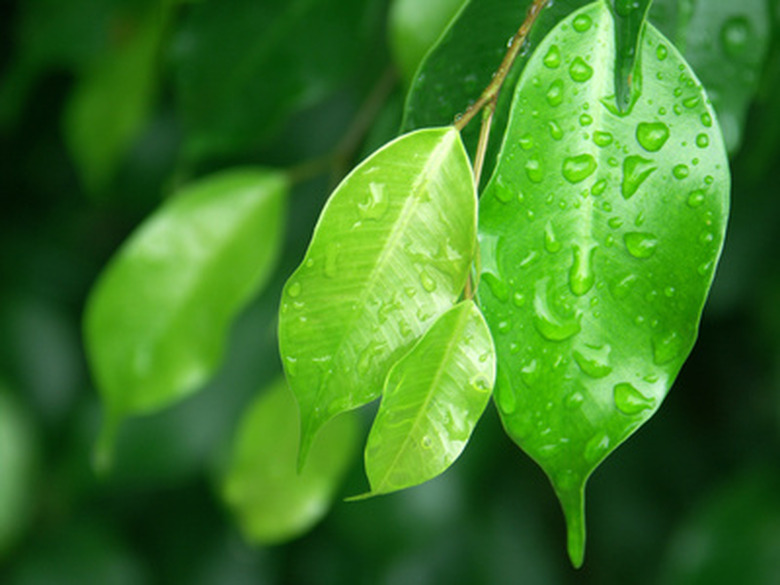How To Propagate Ficus Trees
The Ficus genus contains over 800 species, native to the tropics. The common fig tree (Ficus carica) is the most famous species, while the ornamental ficus trees, such as F. benjamina (weeping fig), F. elastica (rubber tree) and F. lyrata (fiddle-leaved fig) are among the most popular houseplants. Native to the world's tropical regions, the ornamental ficus varieties do not bear fruit and are grown for their striking shapes and foliage. Ficus propagation from cuttings is a simple process.
Step 1
Fill a small planting pot with coarse sand or orchid bark. Water the medium until it is drenched and allow the pot to drain completely. Use a pencil or other pointed object to create a 2-inch planting hole in the soil.
- The Ficus genus contains over 800 species, native to the tropics.
- Native to the world's tropical regions, the ornamental ficus varieties do not bear fruit and are grown for their striking shapes and foliage.
Step 2
Cut a 4-inch-long piece from the tip of a ficus tree branch. Make the cutting at a 45-degree angle.
Step 3
Remove the leaves from the bottom half of the cutting. Dip the angled end of the cutting into the rooting hormone deep enough so that at least one leaf node is covered.
Step 4
Stick the cutting into the planting hole until it is buried to just below the bottom leaves. Pack the planting medium around the cutting.
Step 5
Place the pot in a plastic bag and seal it. The soil temperature needs to remain between 70 to 75 degrees Fahrenheit so use a heat mat if needed. Place the ficus cutting in an area that receives indirect sunlight.
- Cut a 4-inch-long piece from the tip of a ficus tree branch.
- Remove the leaves from the bottom half of the cutting.
Step 6
Check the soil periodically to make sure that it remains moist.Your cutting should root within eight weeks, at which time you should remove it from the bag, keep the soil moist and place it back in indirect sunlight.
Ficus Trees
Several types of ficus trees grow outdoors or as houseplants. Most ficus trees do well in full sun but can tolerate some shade for a portion of the day. For trees grown indoors, place your plant in a spot that receives bright, indirect light for at least the morning hours. Ficus trees need regular moisture during their growing season and should be watered whenever the top 1 inch of soil is dry. They tolerate dry spells poorly and can drop their leaves if subjected to fully dry soil for any period of time. The leaves will usually re-grow but, for a fruiting tree, drought can prevent fruit from setting. Remove these whenever you see them.
- Several types of ficus trees grow outdoors or as houseplants.
- Most ficus trees do well in full sun but can tolerate some shade for a portion of the day.
Ficus Trees
Several types of ficus trees grow outdoors or as houseplants. Most ficus trees do well in full sun but can tolerate some shade for a portion of the day. For trees grown indoors, place your plant in a spot that receives bright, indirect light for at least the morning hours. Ficus trees need regular moisture during their growing season and should be watered whenever the top 1 inch of soil is dry. They tolerate dry spells poorly and can drop their leaves if subjected to fully dry soil for any period of time. The leaves will usually re-grow but, for a fruiting tree, drought can prevent fruit from setting. Remove these whenever you see them.
- Several types of ficus trees grow outdoors or as houseplants.
- Most ficus trees do well in full sun but can tolerate some shade for a portion of the day.
Things Needed
- Planting pot
- Coarse sand or orchid bark
- Sharp pruning shears
- Rooting hormone
- Transparent plastic bag
- Heat mat
References
- Texas A&M University AgriLife Extension: Propagating Foliage and Flowering Plants
- North Dakota State University Extension Service: Questions on Ficus
- "Foliage Houseplants"; James Underwood Crockett; 2001
- Missouri Botanical Garden: Ficus Benjamina
- Missouri Botanical Garden: Ficus Carica
- Missouri Botanical Garden: Ficus Lyrata
- Missouri Botanical Garden: Ficus Elastica
- Missouri Botanical Garden: Ficus Benjamina
- Missouri Botanical Garden: Ficus Carica
- Missouri Botanical Garden: Ficus Lyrata
- Missouri Botanical Garden: Ficus Elastica
